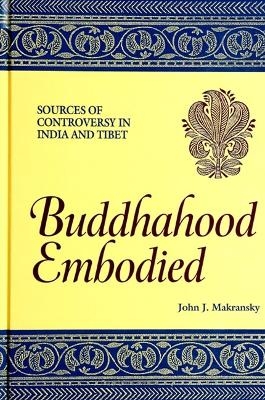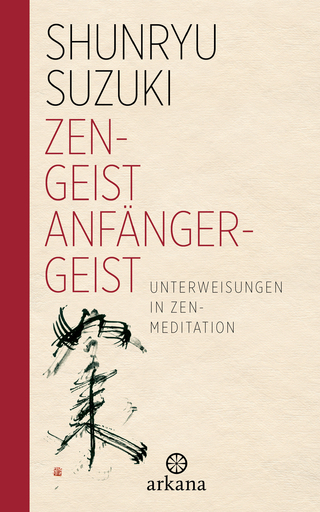
Buddhahood Embodied
State University of New York Press (Verlag)
978-0-7914-3431-4 (ISBN)
- Titel z.Zt. nicht lieferbar
- Versandkostenfrei innerhalb Deutschlands
- Auch auf Rechnung
- Verfügbarkeit in der Filiale vor Ort prüfen
- Artikel merken
To enter the Mahayana Buddhist path to enlightenment is to seek both to become free from our dualistic, deluded world and to remain actively engaged in that world until all others are free. How are these two apparently contradictory qualities to be embodied in the attainment of buddhahood (dharmakaya)? How can one's present practice accomplish that? These questions underlie a millennium-old controversy over buddhahood in India and Tibet that centers around a cherished text, the Abhisamayalamkara. Makransky shows how the Abhisamayalamkara's composite redaction, from Abhidharma, Prajnaparamita, and Yogacara traditions, permitted its interpreters to perceive different aspects of those traditions as central in its teaching of buddhahood. This enabled Indians and Tibetans to read very different perspectives on enlightenment into the Abhisamayalamkara, through which they responded to the questions in startlingly different ways.
The author shows how these perspectives provide alternative ways to resolve a logical tension at the heart of Mahayana thought, inscribed in the doctrine that buddhahood paradoxically transcends and engages our world simultaneously. Revealing this tension as the basis of the Abhisamayalamkara controversy, Makransky shows its connection to many other Indo-Tibetan controversies revolving around the same tension: disagreements over buddhahood's knowledge, embodiment, and accessibility to beings (in Buddha nature and through the path). Tracing the source of tension to early Mahayana practice intuitions about enlightenment, the author argues that different perspectives in these controversies express different ways of prioritizing those practice intuitions.
John J. Makransky is Assistant Professor of Buddhist Studies and Comparative Theology at Boston College.
Preface
Acknowledgments
Abbreviations
Chapter 1:
Introduction
1.1 Basic Questions
1.2 Long Controversy over the Abhisamayalamkara on Buddahood
1.3 Historical and Textual Issues behind the Controversy
1.4 Philosophical and Theological Concerns behind the Controversy
1.5 Wider Implications for the History of Mahayana Thought
Chapter 2:
The Buddha's Body of Dharmas (Dharmakaya) in Sarvastivada Abhidharma
Chapter 3:
The Buddhas' Embodiment of Dharma(ta) (Dharmakaya) in Prajñaparamita Sutras
Chapter 4:
Embodiment of Buddhahood in its Own Realization: Yogacara Svabhavikakaya as Projection of Praxis and Gnoseology
4.1 Relevance of Yogacara texts to Abhisamayalamkara Chapter 8
4.2 Defining Principle of Buddhahood in Classical Yogacara: Dharmakaya as Realization of Thusness, not Buddha Dharmas per se
4.3 Yogacara Sixfold Analysis of Buddhahood: "Essence" (Svabhava) Corresponds to Svabhavikakaya
4.4 Meanings Implicit in Kaya Name Morphologies: Embodiment of Buddhahood in its Essence (Svabhavika), in its Communal Enjoyment of Dharma (Sambhogika), in its Manifestations (Nairmanika)
4.5 Two Meanings of Dharmakaya in Yogacara, with the Term Svabhavikakaya Mediating between Them
4.6 Svabhavikakaya as a Direct Extrapolation from Yogacara Meditational Praxis and Gnoseology
4.7 Summary
Chapter 5:
Enlightenment's Paradox: Nondual Awareness of the Unconditioned (Svabhavikakaya) Embodied in Conditioned Activity for Beings (Sambhogikakaya, Nairmanikakaya)
5.1 Buddhahood as Nonabiding Nirvana (Apratisthita Nirvana)
5.2 Svabhavikakaya as Ontological Foundation of the Rupakayas, Epistemologically Exclusive to Buddhas
5.3 The Paradox of Buddhahood as Nonabiding Nirvana: Unconditioned Basis of Pervasive Activity in a Conditioned World
5.4 Paradox of a Buddha's Awareness: Inseparable from Unconditioned Thusness, yet Operative in the Conditioned World
5.5 Sambhogikakaya as Embodiment in Communal Enjoyment, Nairmanikakaya as Manifold Manifestations for Limitless Activity
Chapter 6:
The Abhisamayalamkara and its Eighth Chapter on Buddhahood
Chapter 7:
Literary-Critical Analysis of Abhisamayalamkara, Chapter 8: A Map that Projects the Three Kayas of Yogacara onto the Large Prajñaparamita Sutra
7.1 Introduction
7.2 Abhisamayalamkara Chapter 8's Textual Basis in the 25,000-verse Prajñaparamita Sutra
a. Late Indian and Tibetan commentators identify rP Passages 8.1-8.3 as the textual basis of AA chapter 8's teaching on the Buddha Kaya
b. Evidence that rP passages 8.1-8.3 were composed after the Abhisamayalamkara and thus could not have been the textual basis for Abhisamayalamkara Chapter 8
1. rP passages 8.1-8.3 are missing in all Chinese translations of the 25,000-verse Prajñaparamita sutra
2. rP passages 8.1-8.3 are missing in all Prajñaparamita sutras extant in Sanskrit and Tibetan except rP
3. rP passages 8.1-8.3 were not part of the Prajñaparamitasutra in Arya Vimuktisena's time
4. Large Prajñaparamita Sutra passages 8.4-8.5 were the actual textual basis for Abhisamayalamkara chapter 8
5. Textual history of rP, and evidence that Haribhadra was its redactor
6. Terms and concepts in Abhisamayalamkara chapter 8 not found in Prajñaparamita passages 8.4-8.5
7.3 Conclusion: Abhisamayalamkara Chapter 8 as a Yogacara-Prajñaparamita Mapping
Chapter 8:
Internal Evidence that Abhisamayalamkara Chapter 8 Teaches the Three Yogacara Kayas
8.1 Introduction: Prajñaparamia and Yogacara Patterns of Thought Relevant to Analysis of Abhisamayalamkara Chapter 8
8.2 Abhisamayalamkara Chapter 8's Table of Contents: AA verse 1.17
8.3 Svabhavikakaya/dharmakaya: Abhisamayalamkara verses 8.1-8.6
8.4 Abhisamayalamkara verses 8.7-8.11
8.5 Sambhogikakaya: Abhisamayalamkara verses 8.12-8.32
8.6 Nairmanikakaya and its Activity: Abhisamayalamkara verses 8.33-8.40
8.7 Conclusion
Chapter 9:
Arya Vimuktisena on Gnoseology and Buddhology in the Abhisamayalamkara
9.1 Introduction
9.2 Correspondence between Arya Vimuktisena's Gnoseology and the Svabhavikakaya of Yogacara
9.3 Arya Vimuktisena on Svabhavikakaya/Dharmakaya
9.4 Arya Vimuktisena on Sambhogikakaya and Nairmanikakaya
9.5 Conclusion
Chapter 10:
Haribhadra's Analytic-Inferential Perspective on Buddhahood: Buddha Dharmas as Fourth "Body"
10.1 Haribhadra's Eighth-Century Lens on Abhisamayalamkara 8
10.2 Translation of Haribhadra's Commentary on the Four Kayas
10.3 Haribhadra's Reinterpretation of Essence Body (Svabhavikakaya )
10.4 Haribhadra's Body of Conditioned Dharmas Consisting of Gnosis (Jñanatmaka Dharmakaya)
10.5 Haribhadra's "Refutation" of the Traditional Three-Kaya Interpretation
10.6 Reading Four Kayas into the Rest of Abhisamayalamkara Chapter 8
10.7 Concluding Remarks
Chapter 11:
Responses by Indian Scholars to Haribhadra's Four Buddha Bodies
11.1 Buddhajñanapada
11.2 Dharmamitra
11.3 Prajñakaramati, Buddhasrijñana, and Kumarasribhadra
11.4 Ratnakarasanti
11.5 Abhayakaragupta
Chapter 12:
The Controversy Continues in Tibet: Tsong kha pa and Go ram pa
12.1 Introduction
12.2 Tsong kha pa's Buddhology
12.3 Go ram pa's Buddhology
Chapter 13:
Sources of Controversy--Nonabiding Nirvana and the Mahayana Quest for Authentic Reinterpretation of the Four Noble Truths
13.1 Introduction
13.2 Mahayana Intuitions of a Buddha's Vast Connection to the World that Pushed up against the Third Noble Truth of Nirvana
a. Nonbiding Nirvana and Universal Emptiness
b. Nonabiding Nirvana, Bodhicitta, and the Bodhisattva Path
c. Nonabiding Nirvana, Buddhanusmrti, and Devotional Practice
d. Nonabiding Nirvana and Buddha-Nature
13.3 Postponement Models of Nirvana as Doctrinal Experiments in the Direction of Nonabiding Nirvana
13.4 Tension Created by Redefining the Third Noble Truth as Nonabiding Nirvana: The Mahayana Quest for Authentic Reinterpretation of the Four Noble Truths as a Whole
13.5 Summary and Conclusions
a. Origins of the Tension in Mahayana Formulations of Buddhahood
b. Nondual Yogic-Attainment Perspective in Mahayana Doctrinal Formation
c. An Eighth-Century Analytic-Inferential Perspective
d. An Eighth-Century Nondual Yogic-Attainment Perspective
e. Opposing Mahayana Ways to Reinterpret the Four Noble Truths
f. Historical, Sociological, and Practical Significance of these Two Perspectives on Buddhahood
Notes
Selected Bibliography
Index
| Erscheint lt. Verlag | 31.7.1997 |
|---|---|
| Reihe/Serie | SUNY series in Buddhist Studies |
| Zusatzinfo | Total Illustrations: 0 |
| Verlagsort | Albany, NY |
| Sprache | englisch |
| Maße | 152 x 229 mm |
| Gewicht | 880 g |
| Themenwelt | Geisteswissenschaften ► Religion / Theologie ► Buddhismus |
| ISBN-10 | 0-7914-3431-1 / 0791434311 |
| ISBN-13 | 978-0-7914-3431-4 / 9780791434314 |
| Zustand | Neuware |
| Haben Sie eine Frage zum Produkt? |
aus dem Bereich


